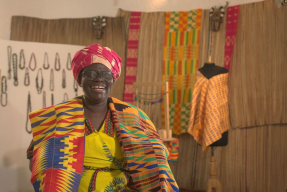Paving the Way to the Future (Part 1): Bad Roads, Transportation Costs and Microfinance in Togo
June 20, 2011
By Kathrin Gerner, KF15, Togo
It becomes apparent with every new rainfall now that the rain season has started in Togo: Roads are the arteries that carry the lifeblood of the economy. They transport goods, employees and clients, and they provide shelf space for the countless street vendors.
Mostly unpaved, however, the roads of Lomé stand no chance in the face of torrential downpours. With few drains to take the water out of the city and the soil already saturated, they turn into a vast, difficult to navigate network of rivers and lakes. The otherwise vibrant Togolese capital comes to a halt and only starts back with a slow crawl when the rain subsides.

What a difference a drain makes: The unpaved road in front of my house on the left, the newly paved boulevard on the right
Even under more favorable conditions, driving through Lomé can feel like crossing an obstacle course. There are small ditches to go around, big ditches to go through, rocks, bricks and other large debris to avoid. Level 2, try this during rush hour or when a shipment of goods has arrived in the neighborhood and all of the small resellers are hauling their merchandise away on handcarts. Level 3, repeat after nightfall on a motorbike with a functioning headlight. Level 4, you guessed it, take the headlight out of the equation.

I don't have to go far to find an accident victim: My housemate Isa getting stitched up at the hospital
It should not come as a surprise, therefore, that transport in and through Togo is viewed as slow and perilous. The accident rate is high, especially after dark. All it takes is an unexpected pothole: one driver brakes suddenly, the driver behind him can’t stop. On motorbikes, helmets are not required. Clothing is thin due to the heat. The results are devastating.
So what does this mean for microfinance, business owners and the economy in general?
Jacques, Marketing Manager at Kiva’s partner organization, WAGES, tells me about the case of his friend Mesa, who owns an import/export business for cloth in Mali. “Mesa no longer does business in Togo. There are too many accidents. Transport is too slow and too costly.” Higher transportation costs, less competition. It does not take a degree in economics to figure out what this means for the price of goods, especially in a country that imports just about everything: milk from France, orange juice from Dubai, jam from Lebanon.
But bad roads don’t only affect the cost of goods. They also affect the cost of financing. While I don’t know what portion of WAGES’ 18% interest rate accounts for the cost of transportation the loans officers incur when visiting their clients, I am convinced that better roads would reduce that cost.
Having spent half an hour each way on the back of a loan officer’s motorcycle to visit Kiva borrower Kokou in his photo studio in the Akodessewa district of Lomé, I only got a small taste of the effort involved to reach a client. Even though three days had passed since the last rainfall, one road was completely blocked due to flooding, the others could more accurately be described as a giant motocross track.
Considering the various problems with unpaved roads, one would expect nothing but outright enthusiasm for the numerous road construction projects that were started in Lomé at the beginning of this year. Reality, however, is not that simple.
Roadwork leads to congestion, forces prolonged road closures, diverts the usual customer streams, dislocates street vendors and causes disruptions in the water supply. And of course, starting a construction project does not necessarily lead to a new road, only finishing does. The road to the future is a rocky one…
~
 Find out more about the difficulties with the current road construction projects in Togo in Part 2 of this series
Find out more about the difficulties with the current road construction projects in Togo in Part 2 of this series
Road Construction and Its Effects on Microfinance in Togo.
~
Kathrin Gerner is a Kiva Fellow (KF15) at WAGES in Lomé, Togo. She drafted this blog series while stuck at her house during a torrential downpour and uploaded it at a café a week later, having kept her balance during the crossing of several flooded streets by way of stepping-stones after yet another heavy rain. To find out more about WAGES, visit its Kiva partner page or the WAGES website. Or show your support by lending to one of its borrowers or joining the WAGES lending team!
PREVIOUS ARTICLE
Microfinance Notes: 17 June 2011 →NEXT ARTICLE
Walking the talk: When a low-income borrower comes to your doorstep →













